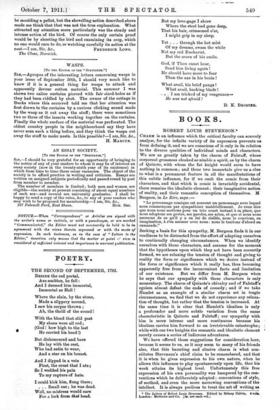SWALLOWS AND MARTINS AND THEIR NEST BUILDING.
[To THE EDITOR OP THE " SPECTATOR!' _I is the general opinion, I believe, that swallows and martins in building their nests bring little lumps of mud in their mouths, which become moistened with saliva, which renders it better for sticking. Yarrell says : " The bird may be seen collecting mud and tempering—it is believed—with saliva." Seebohm remarks : " It has been said that the bird sticks the little mud pellets of its nest together with its saliva." From what I observed last July in the action of a martin picking up some mud, I am strongly under the im- pression that the bird swallows it. Whilst I was walking on the pathway a martin lit down in the middle of the road at a distance of about eight or ten feet in a line exactly opposite me, so that I had a good view of it. It did not pick up a pellet and then fly off, but began to move along in a straight line and to push the lower bill along, and so, as it were, to shovel the mud into its mouth. These actions were continued for about eight inches, and then the bird flew away. The continued interrupted action had all the appearance of the mud being swallowed. The idea of a bird rolling a pellet of mud in its mouth and so getting it moistened by the very small quantity of saliva has always seemed to me too fanciful and not exactly scientific. Whilst in the crop the mud gets moistened with mucus, and then at the nest the bird brings it up again in the same way as when it is feeding its young ones. If it were only one small pellet the bird would quickly fix that and fly away at once; but instead of that it stays on the nest some minutes, and can be seen carefully manipulating the mud with its beak. When a swallow or martin is picking at the mud at the edge of a pit or the side of the road, it certainly looks as if it might
be moulding a pellet, but the shovelling action described above made me think that that was not the true explanation. What attracted my attention more particularly was the steady and intense action of the bird. Of course the only certain proof would be by shooting the bird and examining its crop, which no one would care to do, or watching carefully its action at the































































 Previous page
Previous page